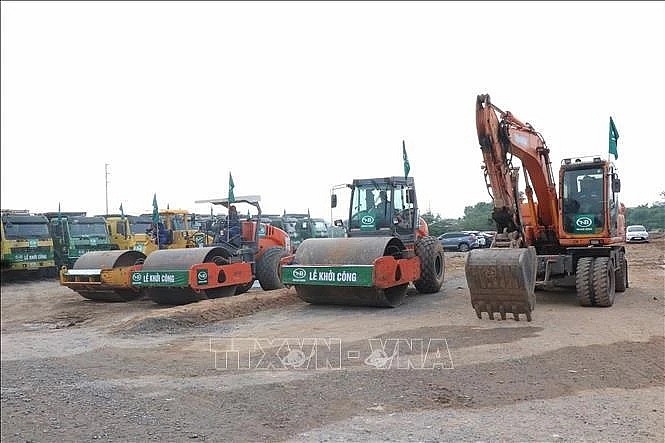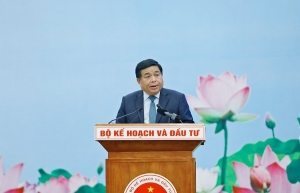Public spending still behind desired level
Disbursement of public investment across the country in the first five months has been deemed poor. As of end-May, about $6 billion has been spent, reaching 22.3 per cent of the plan assigned, and equivalent to the same rate during the same period last year.
 |
| The disbursement of public investment from the State budget in the first five months of this year was estimated to reach 190.6 trillion VND (7.44 billion USD), equal to 26.6% of the yearly target. (Photo: VNA) |
Reporting to the government on the result in early June, Minister of Planning and Investment Nguyen Chi Dung said that 10 ministries or state agencies and 30 localities reported a disbursement rate higher than 25 per cent of the plan assigned. However, numerous localities reported very poor performance.
“After five months, 33 ministries and state agencies, as well as 29 localities, reported a disbursement rate below the national average. Of these, four ministries and agencies have not disbursed any amount of the 2024 state budget investment plan, and some key projects are even behind schedule,” Minister Dung said.
In addition to the Ring Road 3 project in Ho Chi Minh City, the Ring Road 4 project in Hanoi also reported slow disbursement, at 9.3 per cent of the annual plan as of the end of April. The Bien Hoa-Vung Tau Expressway construction phase 1 is at 7.8 per cent of the annual plan, and the Khanh Hoa-Buon Ma Thuot Expressway phase 1 stands at 13.5 per cent.
Ring Road 4 is about five months late, Ring Road 3 is nearly two months late, the expressway for Chau Doc, Can Tho, and Soc Trang has been delayed by a further six weeks, and Khanh Hoa-Buon Ma Thuot is nearly two months late.
“When key projects are delayed, public investment disbursement of the country will be affected remarkably,” Dung said.
Ho Chi Minh City is one of the worst-performance localities. Only VND10.9 trillion ($445 million) out of nearly $3.26 billion of public spending has been carried out in the first five months of the year. Phan Van Mai, Chairman of Ho Chi Minh City’s People’s Committee, said that it would inspect every project and contractor, and consider penalties for poor-performing construction units.
“In April-May, we planned to disburse about $143-163 million every week, but only $8 million was managed. There must be a solution to improve significantly in June,” Mai said.
Nguyen Hoang Anh Dung, deputy director of Ho Chi Minh City Urban Infrastructure Construction Investment Management Unit, said that many projects were facing difficulties in site clearance at present, including two projects at Xuyen Tam Canal and north of Doi Canal that accounted for 69 per cent of total public investment assigned to the unit.
“In the Xuyen Tam project, the site clearance in Binh Thanh district worth $220 million has not yet been approved for a compensation plan,” Dung said. “The north Doi Canal project is worth $110 million for site clearance, and we are trying to solve the issue but still with no results.”
Luong Minh Phuc, director of Ho Chi Minh City Traffic Construction Investment Management Unit, said that spending on traffic projects usually came in the third and fourth quarters. “We are implementing solutions to speed up the progress of many projects. In the remaining time, an average of $57 million should be disbursed every month, which has already been planned and assigned for every project,” Phuc said.
In a recent document criticising eight units, Ho Chi Minh City People’s Committee listed 60 projects and utilities that were too slow in disbursing public investment, although the city had directed and urged them previously. Some 29 projects and utilities reported poor disbursement, although there had been instructions to resolve problems for the second time.
To accelerate disbursement across the country, earlier in June the Ministry of Planning and Investment issued directions to promote disbursement of the state budget investment plan this year and completing recovery of all advanced capital. It also asked to establish steering committees, and working groups to remove obstacles and promote disbursement.
“Members of these groups must proactively review, urge, coordinate and support investors and project management units during the implementation process and promptly resolve difficulties and problems related to related procedures in their management and handling authority,” said Minister Dung.
Moreover, monthly and quarterly disbursement plans should be built and detailed for each task and project. Leaders should be assigned to monitor the implementation progress and disbursement of each task and project according to the set plan, urging and promptly removing difficulties for each project. “The disbursement results of each task and project assigned to monitor are the basis for evaluating the emulation and performance in 2024 for the leaders of authorities,” the minister said.
At the regular meeting of the government in early June, the prime minister highlighted that the goal is still to disburse 95 per cent of the assigned capital.
 | Minister pledges public investment disbursement push The Ministry of Planning and Investment (MPI) is determined to expedite the disbursement of public investment funds this year, while eliminating inefficiencies in investment allocation, with the goal of exceeding the 65.1 per cent disbursement rate of 2023. |
What the stars mean:
★ Poor ★ ★ Promising ★★★ Good ★★★★ Very good ★★★★★ Exceptional
Related Contents
Latest News
More News
- Kolon signs $48 million airbag supply deal with Autoliv (December 15, 2025 | 18:14)
- National Assembly approves Vinh–Thanh Thuy expressway project (December 15, 2025 | 18:02)
- Quang Tri green-lights $1.59 billion LNG-fired power project (December 15, 2025 | 17:59)
- Stress laid on high-quality FDI inflows (December 15, 2025 | 11:00)
- Can Tho utilises its growth advantages (December 15, 2025 | 09:09)
- Ca Mau unlocking potential to shape a more sustainable future (December 15, 2025 | 09:02)
- Major projects to be inaugurated nationwide (December 15, 2025 | 08:00)
- MoF workshop highlights mounting concerns over ODA on-lending costs (December 12, 2025 | 16:05)
- National Assembly approves pilot mechanisms to accelerate major projects in Hanoi (December 12, 2025 | 11:29)
- Legislation gives government flexibility for loan guarantees (December 11, 2025 | 18:04)

 Tag:
Tag:





















 Mobile Version
Mobile Version